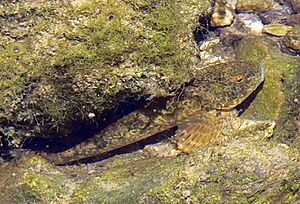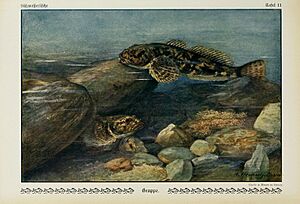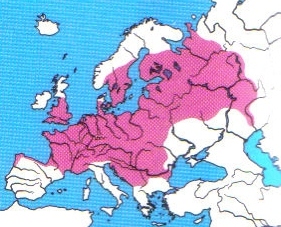European bullhead facts for kids
Quick facts for kids European bullhead |
|
|---|---|
 |
|
| Conservation status | |
| Scientific classification | |
| Synonyms | |
|
The European bullhead (Cottus gobio) is a cool freshwater fish that lives in many rivers across Europe. It's part of the Cottidae family, which are also known as sculpins. People also call it the miller's thumb, freshwater sculpin, common bullhead, or cob.
This small fish usually stays near the bottom of the water. It loves cold, clear, fast-flowing streams and medium-sized rivers. You can also find it on the rocky shores of cold lakes. Sometimes, it even lives in slightly salty water in the northern Baltic Sea.
What Does It Look Like?
The bullhead has a big, wide head and a body that gets narrower towards its tail. It has large fins and a rounded tail. Its eyes are placed high up on its head.
It's usually about 6 to 8 centimeters (2.4 to 3.1 inches) long. Its body is light brown with darker spots, helping it blend in with the riverbed. Its bottom fins are clear and don't have stripes, which helps tell it apart from other similar fish.
When a bullhead rests on the bottom, its side fins spread out like wings. This makes it look like it's ready to take off!
Life and Habits
European bullheads mostly eat insects, tiny crustaceans, and other small creatures that live on the riverbed. They are always looking for their next meal among the rocks and plants.
Reproduction
Bullheads lay their eggs in the spring. The male fish digs a small, shallow hole in the riverbed. Several females will then lay their eggs in this nest.
After the eggs are laid, the male bullhead becomes the guard. He protects the nest for about a month until all the eggs hatch. This is a very important job to keep the baby fish safe!
Where Do They Live?
The European bullhead lives in many parts of Europe, including the United Kingdom. However, you won't find them in the very southern parts of Europe or in northern Scandinavia.
It's interesting because what we call the "European bullhead" isn't just one single type of fish. Scientists have found that there are actually many different kinds of bullheads that look a bit different or have different genes.
For example, the bullheads found in Great Britain are often called Cottus perifretum. Even though they have a different scientific name, many people in the UK still refer to them as Cottus gobio. Scientists are always learning more about these amazing fish!




